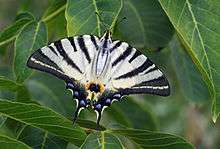Scarce swallowtail
| Scarce swallowtail | |
|---|---|
 | |
| Scientific classification | |
| Kingdom: | Animalia |
| Phylum: | Arthropoda |
| Class: | Insecta |
| Order: | Lepidoptera |
| Family: | Papilionidae |
| Genus: | Iphiclides |
| Species: | I. podalirius |
| Binomial name | |
| Iphiclides podalirius (Linnaeus, 1758) | |
The scarce swallowtail (Iphiclides podalirius) is a Palearctic swallowtail butterfly found in gardens, fields and open woodlands. First described by Carl Linnaeus in 1758, it is found in places with sloe thickets and particularly orchards. It is also called the sail swallowtail or pear-tree swallowtail. The southern swallowtail (Iphiclides feisthamelii) is sometimes treated as a subspecies. Despite the name ("scarce"), this swallowtail is quite common.
Description
 Male
Male Male underside
Male underside Female
Female Female underside
Female underside
Distribution
It is widespread throughout Europe with the exception of the northern parts. Its range extends northwards to Lower Lusatia and central Poland and eastwards across Asia Minor and Transcaucasia as far as the Arabian Peninsula, Pakistan, India and western China. A few specimens of the scarce swallowtail have been reported from central Sweden and the UK but they were probably only strays and not migrants. The scarcity of UK migrants is responsible for the English common name. In the Alps it can be found up to altitudes of 1600 m.
The presence of Iphiclides podalirius in the floodplain of the Morava River in the Slovak Republic have been found to be a good indicator of relatively well preserved xerothermic grassland habitats with forest-steppe vegetation, which have no cutting history.[1]
Status
In some years the scarce swallowtail is quite abundant. The scarce swallowtail is getting rarer as the blackthorn bushes are being cleared. The butterfly is now protected by law in the Czech Republic, Slovakia, Germany, Hungary, Luxembourg, Russia and Poland.[2] It is considered rare and endangered and protected in some provinces of Austria and of indeterminate status throughout Europe. Though referred by some authorities to be of status "vulnerable",[1]:46[3] it is however unlisted in the IUCN Red List[4] and the CITES appendices I, II and III.[5]
Habitats and life cycle
- Caterpillar
 Pupa
Pupa Imago
Imago
Iphiclides podalirius is polyphagous feeding on Crataegus (Finland), Crataegus monogyna (Palaearctic), Malus pumila (Palaearctic), Prunus (Finland, Palaearctic), Prunus armeniaca (Palaearctic, Spain), Prunus avium (Palaearctic, Spain) Prunus cerasus (Palaearctic, Russia), Prunus domestica (Palaearctic), Prunus dulcis (Palaearctic, Spain), Prunus padus (Palaearctic), Prunus persica (Palaearctic), Prunus spinosa (Palaearctic), Pyrus (Palaearctic) and Sorbus aucuparia (Palaearctic). The caterpillars spin little pads on leaves and grip them firmly. The newly hatched caterpillar is dark in colour with two smaller and two bigger greenish patches on the dorsal side; later they are greenish with yellowish dorsal and side stripes. The summer chrysalids are green as a rule, the hibernating ones are brown. A number of hibernating chrysalids fall prey to various enemies.
The caterpillars of the scarce swallowtail have been noted to leave silk trails from the permanent resting sites to feeding sites. This has been seen in both solitary and territorial larvae with larvae having the ability to discern their trails from those of others.[6]
Research on pupae of Iphiclides podalirius in Spain indicates that the pupae manifest in two colours, green and brown, for the purpose of camouflage. The green pupae develop on host plants and develop directly while brown pupae enter into diapause in the leaf litter. Pupating larvae tend to form green pupae before August while after August they tend to form brown pupae. Duration of the photophase or light period appears to be the mechanism which dictates the path of development of the pupa. The results suggest that the green pupa develop on food plants to avoid predation by small mammals and visual avian predators while the brown pupa develop on leaf litter to avoid avian predators.[7]
See also
| Wikimedia Commons has media related to Iphiclides podalirius. |
References
- Collins, N. Mark; Morris, Michael G. (1985). Threatened Swallowtail Butterflies of the World: The IUCN Red Data Book. Gland & Cambridge: IUCN. ISBN 978-2-88032-603-6.
References
- 1 2 Kulfan, Miroslav; Degma, Peter; Kalivoda, Henrik (1995). "Lepidoptera of different grassland types across the Morava floodplain" (PDF). Journal of Research on the Lepidoptera. 34: 39–47. Retrieved 27 October 2010.
- ↑ Collins, N. Mark; Collins, Michael G. (1985). Threatened Swallowtails of the World: the IUCN red data book. IUCN Protected Area Programme Series. Gland, Switzerland and Cambridge, U.K.: IUCN. p. 45. ISBN 978-2-88032-603-6. Retrieved 22 October 2010.
- ↑ Popov, 1989. On research of Lepidoptera, Rhopalocera population of Carpathian State Reserve. /S.G. Popov// Information Report of thesis, IV Conference of young scientists. 1-3 of June 1989 devoted to 70 Anniversary of YCL. Uzhgorod, 1989:138.
- ↑ A search for "Iphiclides" in the search facility of the IUCN Red List web site provides no result. Accessed 27 October 2010.
- ↑ "Appendices I, II and III to CITES". Convention on International Trade on Endangered Species. As of 14 Oct 2010. Retrieved 23 September 2010. Check date values in:
|date=(help). No mention found in the document. - ↑ Weyh, R.; Maschwitz, U. "Individual trail marking by larvae of the scarce swallowtail Iphiclides podalirius L. (Lepidoptera; Papilionidae)". Oecologia. 52 (3): 415–316. doi:10.1007/BF00367969.
- ↑ Stefanescu, C. (2004). "Seasonal change in pupation behaviour and pupal mortality in a swallowtail butterfly" (PDF). Animal Biodiversity and Conservation. 27 (2): 25–36. Retrieved 28 October 2010.
External links
- European Butterflies and Moths
- Scarce swallowtail on Butterflycorner.net